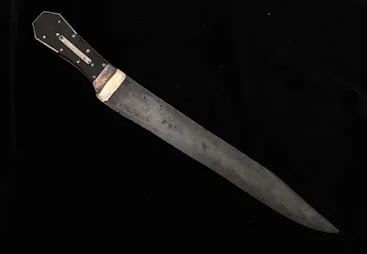Studying Arkansas history nearly all my life, I’ve learned that much of it is part legend and part fact — with the truth somewhere in the middle.
This could not be more true than with the story of the Bowie knife. Hundreds of articles and books (including one co-written by my former boss Bill Worthen) have been written about the history of the knife. Despite all the research, no one seems to know the true origin of the legendary weapon made famous by one of the heroes of the Texas revolution, Jim Bowie. But one thing that most historians and scholars agree on is that at least one of the first bowie knives was made here in Arkansas by blacksmith James Black.
Black was born around 1800 in New Jersey. At age 8, he ran away from home and found himself in Philadelphia. There, he became the apprentice to a silverplater, Stephen Henderson. Black left the apprenticeship as a highly skilled silverplater and headed west to settle in Bayou Sara, Louisiana, where he opened his first blacksmith's shop. Some stories say Black met Bowie for the first time there around 1822, but this can't be verified.
In 1823, Black moved to the small town of Washington (Hempstead County), near the Red River.
About a year later, Black was hired by William Shaw, who owned a successful blacksmith's shop in Washington. It was there that Black built a reputation as one of the best blacksmiths in the area, and soon Shaw made Black a partner in the business.
While working with Shaw, Black fell in love with Shaw’s oldest daughter, Anne. But her father strongly opposed the relationship, which led to Black leaving the business — and Washington.
After settling on the Rolling Fork River in what is now Sevier County, Black opened another blacksmith's shop and a grist mill. But Black returned to Washington after the federal government declared the land part of Indian Territory.
Once Black returned, he renewed his forbidden relationship with Anne, and the two were married in June 1828 at the Hempstead County Courthouse in Washington. The couple were married for seven years and had five children. Black opened a blacksmith's shop and business boomed.
It was at this shop in December 1831 where Black reportedly forged a knife for Bowie using Bowie's design. Many believe this is the knife Bowie used in the failed defense of the Alamo in San Antonio.
Anne Shaw Black died in September 1835. Shortly after, Black became gravely ill and was attacked by his father-in-law, who was not only still angry at his daughter’s marriage to Black but also jealous of Black’s fame as the area's premier blacksmith.
Black was blinded by the attack and was forced to close his business. Black died on June 21, 1872, in Washington. Newspapers from all over the country carried the news of the death of the man who created the famous Bowie knife.
Several years ago, a knife with the engraving "Bowie No. 1" on its handle, attributed to Black through scientific analysis, was acquired from a Texas collector by the Historic Arkansas Museum in Little Rock.
Is this the true Bowie knife? Like many things in Arkansas history, we may never know.

Comments
Post a Comment